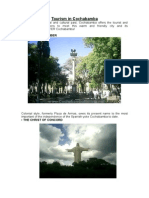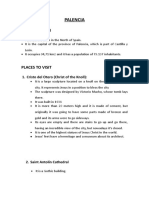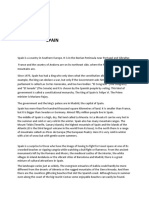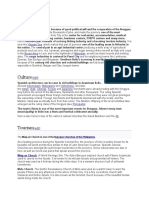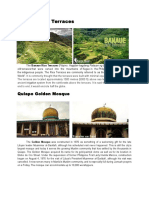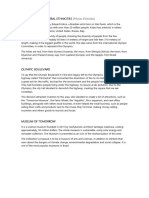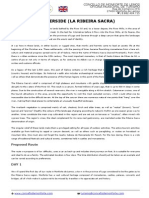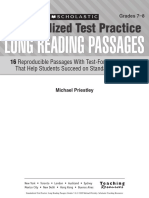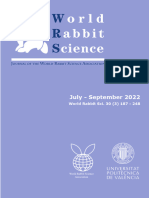Moquegua Tourism
Moquegua Tourism
Uploaded by
Arianna Saud0 ratings0% found this document useful (0 votes)
36 views2 pagesThe major tourist sites in Moquegua, Peru include the Main Square of Moquegua, the Santo Domingo Cathedral, the Ornamental Fountain, the Wall of the Main Church, the Constitution Museum, and Puerto Ilo. The Main Square is the center of the city and features an iron ornamental pool designed by Gustave Eiffel. The Santo Domingo Cathedral was the first cathedral built in the Americas. Puerto Ilo is a city located on the Pacific coast that was historically home to pre-Columbian cultures and is now an important port and commercial center for the mining and energy industries in the Moquegua region.
Original Description:
Copyright
© © All Rights Reserved
Available Formats
DOCX, PDF, TXT or read online from Scribd
Share this document
Did you find this document useful?
Is this content inappropriate?
The major tourist sites in Moquegua, Peru include the Main Square of Moquegua, the Santo Domingo Cathedral, the Ornamental Fountain, the Wall of the Main Church, the Constitution Museum, and Puerto Ilo. The Main Square is the center of the city and features an iron ornamental pool designed by Gustave Eiffel. The Santo Domingo Cathedral was the first cathedral built in the Americas. Puerto Ilo is a city located on the Pacific coast that was historically home to pre-Columbian cultures and is now an important port and commercial center for the mining and energy industries in the Moquegua region.
Copyright:
© All Rights Reserved
Available Formats
Download as DOCX, PDF, TXT or read online from Scribd
Download as docx, pdf, or txt
0 ratings0% found this document useful (0 votes)
36 views2 pagesMoquegua Tourism
Moquegua Tourism
Uploaded by
Arianna SaudThe major tourist sites in Moquegua, Peru include the Main Square of Moquegua, the Santo Domingo Cathedral, the Ornamental Fountain, the Wall of the Main Church, the Constitution Museum, and Puerto Ilo. The Main Square is the center of the city and features an iron ornamental pool designed by Gustave Eiffel. The Santo Domingo Cathedral was the first cathedral built in the Americas. Puerto Ilo is a city located on the Pacific coast that was historically home to pre-Columbian cultures and is now an important port and commercial center for the mining and energy industries in the Moquegua region.
Copyright:
© All Rights Reserved
Available Formats
Download as DOCX, PDF, TXT or read online from Scribd
Download as docx, pdf, or txt
You are on page 1of 2
Moquegua Tourism
Major tourist sites
• Main Square of Moquegua
The Plaza Mayor is the main urban space of the Peruvian city of Moquegua since its foundation in
1540. On one of its sides is the cathedral. The square is located in the center of Moquegua, it is
the center of the city's activity
It is located in the center of the city of Moquegua, with a unique colonial style and semi-closed with
centennial ficuses, which enhance its beauty. It has an Iron Ornamental Pool designed by Gustavo
Eiffiel, and where the 3 graces of Greek mythology shine: Aglaya, Talía and Edrosine.
• Santo Domingo Cathedral
Built between 1510 and 1540, the first cathedral in the Americas, known as Santa Iglesia Catedral
Basílica Nuestra Señora de la Encarnación or Annunciación, Primada de América, continues to
stand tall in all its splendor over the heart of the Colonial City.
Rodrigo de Liendo, born Rodrigo Gil de Rozillo, was a 16th-century Spanish architect and one of
the most important stonemasons on Hispaniola in his time. In 1525 it was moved to Santo
Domingo de Guzmán to build the temple of the Mercedarian order. Construction began in 1527
and it was completed in 1555.
• Ornamental Fountain
In ornamental fountains, the water is propelled through a pump to the outside, producing various
aesthetic effects. In some cases the water can also flow by gravity. In the accumulated water there
are the necessary conditions for the existence of plant or animal life.
• Wall of the Main Church
The masonry stone façade of this church, built in 1660 and rebuilt in 1792, stands out. Some
"stonemasons' marks" can be seen on it to certify the participation of the indigenous communities
in its construction. On the inner side there is a mural also painted by indigenous artists at the end
of the 18th century.
• Constitution Museum
The Contisuyo Museum is a Peruvian museum, which is located in the department of Moquegua.
It is located in what was part of the Mother Church of Moquegua. The museum is dedicated to the
history of Moquegua. It houses pieces from the Wari, Tiahuanaco, Chiribaya, Tumilaca and
Estuquiña cultures.
• White Christ Viewpoint
The White Christ is the most famous monument in the city of Cusco. It is a statue of Jesus Christ
that reaches 8 meters high and raises its arms as a sign of protection at the top of the city. It is
located next to the Sacsayhuaman fortress. Admission to this monument is free.
• Puerto Ilo
Ilo is a city in southwestern Peru, capital of the province of the same name in the department of
Moquegua, located on the shores of the Pacific Ocean south of the mouth of the Osmore River
and north of Punta Coles. It is located 140 km from the city of Moquegua and has a population of
79, 118 inhabitants according to the XII Population Census, VII Housing and III Indigenous
Communities 2017.1
The area was the place where the Chinchorro Culture and the Chiribaya Culture settled during
their pre-Columbian times. For centuries its economy has revolved around the production of
olives, as well as fishing that has been developed since it was a fishermen's cove in 1818, but it is
in the 50s that the economic activity of the port had a great growth thanks to the boom in the
fishing industry and the entry of foreign capital from the company Southern Peru in the exploitation
of mining deposits in the region.
It is one of the main ports in the south of Peru and the one that has the greatest importance for the
Government of Bolivia due to the large investments it wants to make due to its location in the
Pacific Ocean. The city of Ilo is considered the financial and commercial center of the Moquegua
region due to the presence of large mining and energy industries, run by the Engie company.
You might also like
- Dont Look BackDocument208 pagesDont Look BackFatima YousufNoch keine Bewertungen
- Soler Del Campo Alvaro - El Arte Del PoderDocument300 pagesSoler Del Campo Alvaro - El Arte Del PoderxtherNoch keine Bewertungen
- Vigan City, Ilocos SurDocument2 pagesVigan City, Ilocos SurArchy CalizoNoch keine Bewertungen
- Homework: QuitoDocument3 pagesHomework: QuitoNickole AsanzaNoch keine Bewertungen
- Touristique Guide (Ejercicio 1)Document21 pagesTouristique Guide (Ejercicio 1)blucianoventuraNoch keine Bewertungen
- South American Ports-Of-Call: CartagenaDocument6 pagesSouth American Ports-Of-Call: Cartagena-Chloe NavarroNoch keine Bewertungen
- World Heritage List Coro No 658Document12 pagesWorld Heritage List Coro No 658Zulibeth Natali Yustiz D VelascoNoch keine Bewertungen
- Tourism in CochabambaDocument7 pagesTourism in CochabambaJuan Carlos Escalera VallejosNoch keine Bewertungen
- History of IntramurosDocument2 pagesHistory of IntramurosAngelico JonesNoch keine Bewertungen
- TUNJADocument3 pagesTUNJALorena SepúlvedaNoch keine Bewertungen
- Itinerary of Quito EcuadorDocument8 pagesItinerary of Quito EcuadorJuan se GuerreroNoch keine Bewertungen
- Visiting Porto and Douro RegionDocument25 pagesVisiting Porto and Douro RegionalfonsogNoch keine Bewertungen
- KE-FWT-QTC (Inglés)Document11 pagesKE-FWT-QTC (Inglés)Amanda SimmonsNoch keine Bewertungen
- Proyecto Final UPDSDocument13 pagesProyecto Final UPDSGustavo MarínNoch keine Bewertungen
- 7 WondersDocument24 pages7 WondersAtharv KothariNoch keine Bewertungen
- Mexico City :: VideoDocument23 pagesMexico City :: VideosmuniverseNoch keine Bewertungen
- Pueblo de Suchitoto: Integrantes: Rodrigo Diaz Abigail Baires Luis Castro Florens AguilarDocument6 pagesPueblo de Suchitoto: Integrantes: Rodrigo Diaz Abigail Baires Luis Castro Florens AguilarRodrigo Antonio Diaz GarciaNoch keine Bewertungen
- Impressive Archeological Sites and RuinsDocument3 pagesImpressive Archeological Sites and RuinsFrank RobNoch keine Bewertungen
- PresentaciónDocument14 pagesPresentaciónNixx sxrxiNoch keine Bewertungen
- Architecture of Cape Verde - WikiwandDocument11 pagesArchitecture of Cape Verde - WikiwandCélio AlvesNoch keine Bewertungen
- Lal-Lo Municipal Tourism Development Plan (2015 - 2020: 17545.htmlDocument9 pagesLal-Lo Municipal Tourism Development Plan (2015 - 2020: 17545.htmlRj FelicisimoNoch keine Bewertungen
- Palencia: 1. Cristo Del Otero (Christ of The Knoll)Document4 pagesPalencia: 1. Cristo Del Otero (Christ of The Knoll)Coral Rodríguez LlamasNoch keine Bewertungen
- Spain: Mares Corina Mihaela Limba EnglezaDocument4 pagesSpain: Mares Corina Mihaela Limba Englezacorina maresNoch keine Bewertungen
- Viaje Turístico ChiclayoDocument5 pagesViaje Turístico ChiclayoRicht VDNoch keine Bewertungen
- My Beautiful City SogamosoDocument3 pagesMy Beautiful City SogamosoleonardoNoch keine Bewertungen
- Parque Nacional Chicamoch1Document7 pagesParque Nacional Chicamoch1Felipe NiñoNoch keine Bewertungen
- Unesco: World Heritage SitesDocument29 pagesUnesco: World Heritage SitesArchit MishraNoch keine Bewertungen
- Trujillo,: The Marinera," Which Is A Typical Dance in Peru, "Cradle of The Typical Peruvian Paso Horse"Document7 pagesTrujillo,: The Marinera," Which Is A Typical Dance in Peru, "Cradle of The Typical Peruvian Paso Horse"Javier VelasquezNoch keine Bewertungen
- Trabajo de InglesDocument7 pagesTrabajo de InglesSandra ValderramaNoch keine Bewertungen
- Walking Tour JulhoDocument9 pagesWalking Tour JulhoAndre SilvaNoch keine Bewertungen
- EconomyDocument2 pagesEconomyIrl CastromayorNoch keine Bewertungen
- 10 PR Places 1Document12 pages10 PR Places 1api-309626874Noch keine Bewertungen
- Trabajo Practico para InglesDocument14 pagesTrabajo Practico para InglesFabri CenturiónNoch keine Bewertungen
- Touristic Places.: By: Alfonso Morales Alfonso Delgado Fernando Delgado Guillermo de JesúsDocument17 pagesTouristic Places.: By: Alfonso Morales Alfonso Delgado Fernando Delgado Guillermo de JesúsMaevaNoch keine Bewertungen
- Hometome Brochure - QuitoDocument2 pagesHometome Brochure - Quitofausto teranNoch keine Bewertungen
- Aspecn1-Group 5 ActivityDocument8 pagesAspecn1-Group 5 ActivityJay PamotonganNoch keine Bewertungen
- The HISTORIC CENTER of LIMA For Its Beautiful Palaces and MansionsDocument1 pageThe HISTORIC CENTER of LIMA For Its Beautiful Palaces and MansionsdonairiNoch keine Bewertungen
- Santiago de CaliDocument16 pagesSantiago de CalielizahanNoch keine Bewertungen
- Unique Experiences: BogotaDocument3 pagesUnique Experiences: BogotaJose Jacob Ortiz MoralesNoch keine Bewertungen
- SSC 2 Topic 7 Module 9Document81 pagesSSC 2 Topic 7 Module 9Julianne Bea NotarteNoch keine Bewertungen
- 15 Iconic Structures of The Philippines - D+C MagazineDocument25 pages15 Iconic Structures of The Philippines - D+C MagazineLeodian Diadem MercurioNoch keine Bewertungen
- Air Travel ManagementDocument48 pagesAir Travel Managementamy tamyNoch keine Bewertungen
- 10 Hospitality Establishments in IntramurosDocument16 pages10 Hospitality Establishments in IntramurosEunice CruzNoch keine Bewertungen
- SPL 1Document8 pagesSPL 1Jean Chryselle TayagNoch keine Bewertungen
- Delatorre-Arch494 R2-C1 Activity 02Document13 pagesDelatorre-Arch494 R2-C1 Activity 02Glyrah Marie Dela TorreNoch keine Bewertungen
- Spanish Town BrochureDocument2 pagesSpanish Town BrochureInfiniti GtwentyNoch keine Bewertungen
- 7 WondersDocument5 pages7 WondersArya SakoreNoch keine Bewertungen
- Boracay Is A Small Island in The Central Philippines.: Banaue (Or Alternatively Spelled As Banawe)Document3 pagesBoracay Is A Small Island in The Central Philippines.: Banaue (Or Alternatively Spelled As Banawe)m cNoch keine Bewertungen
- Tour GuidingDocument7 pagesTour GuidingSara PineroNoch keine Bewertungen
- Banaue Rice TerracesDocument5 pagesBanaue Rice TerracesEllaAdayaMendiolaNoch keine Bewertungen
- Historic Centre of MacauDocument4 pagesHistoric Centre of MacauHarish GuptaNoch keine Bewertungen
- NCRDocument152 pagesNCRAlfred Gonzales AdriasNoch keine Bewertungen
- Full-Day Quito Full-Day Cuenca Full-Day GuayaquilDocument6 pagesFull-Day Quito Full-Day Cuenca Full-Day GuayaquilCotococha Lodge EcuadorNoch keine Bewertungen
- Melaka and George TownDocument4 pagesMelaka and George TownAnggihsiyahNoch keine Bewertungen
- (INGLÊS) Centro HistóricoDocument3 pages(INGLÊS) Centro HistóricoUbbe BorealNoch keine Bewertungen
- Heto311 Week+14+LectureDocument25 pagesHeto311 Week+14+Lectureatylagan1332lagNoch keine Bewertungen
- Miguel Ángel Fernández OrtizDocument12 pagesMiguel Ángel Fernández OrtizCoral Rodríguez LlamasNoch keine Bewertungen
- RPH Main Topic5Document4 pagesRPH Main Topic5Jen TenorioNoch keine Bewertungen
- The Ribeira SacraDocument14 pagesThe Ribeira SacraTareixa TrigoNoch keine Bewertungen
- CDMX PresentationDocument27 pagesCDMX PresentationJonathan VelascoNoch keine Bewertungen
- Routes Around Santander DefinitiveDocument4 pagesRoutes Around Santander DefinitiveAndrew PerishNoch keine Bewertungen
- Cruises... in a different way! Travel Guide Canary Islands 2019/2020: Teneriffa, Fuerteventura, Gran Canaria, Lanzarote, La Palma, La GomeraFrom EverandCruises... in a different way! Travel Guide Canary Islands 2019/2020: Teneriffa, Fuerteventura, Gran Canaria, Lanzarote, La Palma, La GomeraNoch keine Bewertungen
- 76 - Going To The Library - CanDocument12 pages76 - Going To The Library - CanOlga AmyNoch keine Bewertungen
- History of Photography 3Document2 pagesHistory of Photography 3DasNoch keine Bewertungen
- KS2: Stone Age To Iron Age: Teachers' NotesDocument7 pagesKS2: Stone Age To Iron Age: Teachers' NotesDorcasNoch keine Bewertungen
- Bardini MuseumDocument1 pageBardini MuseumHaley HermanNoch keine Bewertungen
- Bstm3a Museo IloiloDocument36 pagesBstm3a Museo IloiloNicole AnnNoch keine Bewertungen
- Midterms ModuleDocument10 pagesMidterms ModuleJoana Francisca VillanuevaNoch keine Bewertungen
- Dokumen - Pub - Light Earth Building A Handbook For Building With Wood and Earth 9783035606454 9783035606348Document312 pagesDokumen - Pub - Light Earth Building A Handbook For Building With Wood and Earth 9783035606454 9783035606348kivitos687Noch keine Bewertungen
- A. Instructions: Underline Each Common Noun and Circle Each Proper Noun. RewriteDocument2 pagesA. Instructions: Underline Each Common Noun and Circle Each Proper Noun. RewritePidol MawileNoch keine Bewertungen
- Quotation BooksDocument16 pagesQuotation Bookskarantiwari901280Noch keine Bewertungen
- Scribal Practice and The Global Cultures of Colophons 1400 1800 Christopher D Bahl All ChapterDocument67 pagesScribal Practice and The Global Cultures of Colophons 1400 1800 Christopher D Bahl All Chapterethel.albanese325100% (13)
- Nouveau Rituel de Kadosh - RagonDocument125 pagesNouveau Rituel de Kadosh - RagonDesire SaccalNoch keine Bewertungen
- Abdi HebaDocument3 pagesAbdi HebaMarcio André SilvaNoch keine Bewertungen
- 12 Independent Study Guide 1 - ARGDocument3 pages12 Independent Study Guide 1 - ARGDanilo bubanNoch keine Bewertungen
- 2.3 Cavite Mutiny 3 - The Alleged Writings of Father BurgosDocument50 pages2.3 Cavite Mutiny 3 - The Alleged Writings of Father BurgosErik BaldadoNoch keine Bewertungen
- Jørn Guldberg: 'Scandinavian Design' As Discourse: The Exhibition Design in Scandinavia, 1954-57Document19 pagesJørn Guldberg: 'Scandinavian Design' As Discourse: The Exhibition Design in Scandinavia, 1954-57Marta Sánchez RivasNoch keine Bewertungen
- Vocabulary Exam 2 JeffDocument9 pagesVocabulary Exam 2 JeffBfp Caraga FsedNoch keine Bewertungen
- Sex Tips For Girls by Guys - DK Publishing - 2012 - DK Publishing - 9780756697631 - Anna's ArchiveDocument242 pagesSex Tips For Girls by Guys - DK Publishing - 2012 - DK Publishing - 9780756697631 - Anna's Archivejuan.ariasrNoch keine Bewertungen
- Standardized Test Practice: Long Reading PassagesDocument96 pagesStandardized Test Practice: Long Reading Passagessachev.satheeshNoch keine Bewertungen
- Big Surprise 4 Unit 6 TestDocument2 pagesBig Surprise 4 Unit 6 TestrosarioNoch keine Bewertungen
- Copia de (Architecture Ebook) Norman Foster PDFDocument9 pagesCopia de (Architecture Ebook) Norman Foster PDFPatricia Urure FloresNoch keine Bewertungen
- Null 3Document67 pagesNull 3kekoucasimir12Noch keine Bewertungen
- đề 17Document6 pagesđề 17SaminNoch keine Bewertungen
- Larry Shiner, Architecture Vs ArtDocument25 pagesLarry Shiner, Architecture Vs ArtMarco Tulio RamírezNoch keine Bewertungen
- Changing PlacesDocument5 pagesChanging PlacesDinaNoch keine Bewertungen
- TodayisArtDay LineSheet Holidays2022Document16 pagesTodayisArtDay LineSheet Holidays2022Pablo NovoaNoch keine Bewertungen
- 11Document182 pages11Victor MartinezNoch keine Bewertungen
- Rules Games and Common Pool ResourcesDocument387 pagesRules Games and Common Pool ResourcesAhmad Zainul Ihsan ArifNoch keine Bewertungen
- Trakai Castle Go VilniusDocument1 pageTrakai Castle Go VilniusGabija DaniNoch keine Bewertungen







